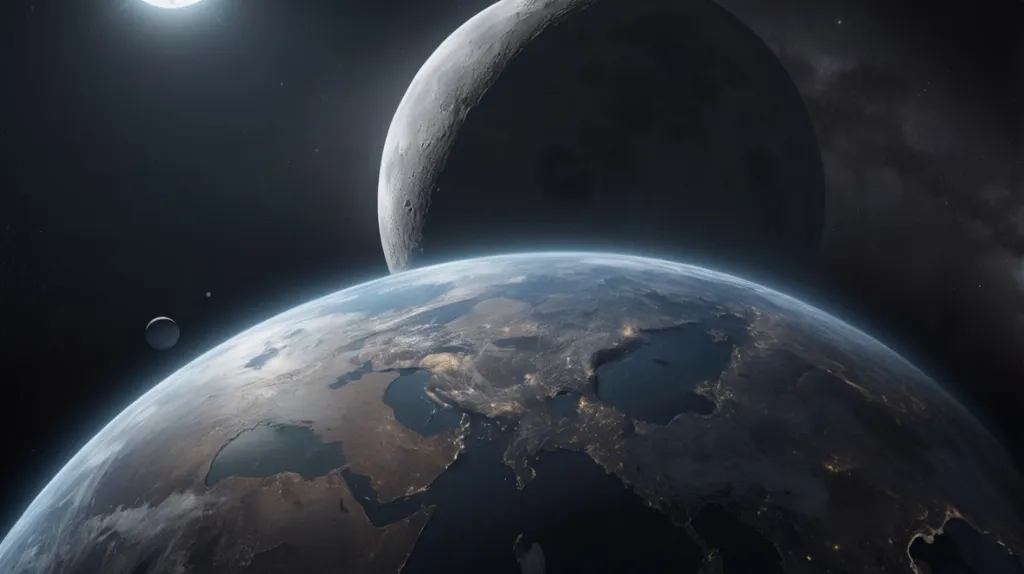Does the Moon’s Distance from Earth Affect Our Dreams?
Posted on: October 24, 2024
Last updated: March 2, 2025
The Moon, with its mystical phases and changing distance from Earth, has intrigued cultures for centuries. Its influence on our emotions, behavior, and even dreams is a topic of ongoing research. Can the Moon’s cycles truly shape the dreams we experience?

The Moon, our closest celestial neighbor, has fascinated and intrigued people worldwide for centuries. Its silvery light illuminates the night sky, and its cyclic phases have inspired poets, artists, and even dream researchers. Different cultures attribute various influences to the Moon, impacting our emotions, decisions, and even the realm of dreams. What significance does the Moon hold for the human mind? Can its cycles, and even its distance from Earth, affect the content and quality of our dreams?
The Moon in Culture and Symbolis
Luna, as the Moon was once called, has become a symbol of not only mystery and intuition but also transformation. In astrology, it is associated with the subconscious and emotions. While its influence on dreams is still being researched, it remains one of the most intriguing mysteries of the human psyche. In ancient beliefs, the Moon was closely tied to rituals and prophecies—people believed it had the power to affect one’s well-being and peace of mind, especially during the full moon.
Changes in the Moon’s Distance
Interestingly, the Moon does not always remain at the same distance from our planet. Due to its elliptical orbit, its distance from Earth changes, making it appear larger and brighter on some nights, especially during a phenomenon called a supermoon. This variability is not just a fascinating visual event—it may also affect physiology and emotions.
Sleep Cycles and the Moon
When the full moon arrives, and the Moon gets closer to Earth, certain correlations between its position and sleep quality can be observed. Although some may dismiss it as mere coincidence, studies suggest that the phases of the Moon can affect sleep and influence the dreams that emerge during these times. In this article, we will explore both the scientific and symbolic aspects of this correlation and consider whether the Moon’s distance truly impacts our dream imagination.
The Moon and Human Behavior – What Do We Know?
For centuries, numerous theories have circulated regarding the Moon’s impact on our health, emotions, and everyday behavior. Observations of nature, tidal phenomena, and sleep rhythms have piqued the interest of researchers. Can the presence of the Moon, particularly the full moon, directly influence human functioning?
Moon Cycles and Sleep
Many people claim that sleep during a full moon tends to be shorter and less peaceful. Often during these nights, there are difficulties falling asleep, and awakening occurs earlier than usual. Is it possible that the phases of the Moon affect sleep physiology? Here’s what research suggests:
- During a full moon, a drop in melatonin levels (the hormone responsible for regulating the sleep-wake cycle) is often observed.
- Scientists point out that it may take up to 5 more minutes to fall asleep, and sleep duration may be reduced by about 20 minutes.
- Observations on study groups also suggest that sleep is shallower during a full moon, leading to less restorative rest.
The Moon and Its Influence on Mood
The full moon phenomenon has long been associated with heightened emotional sensitivity. Folk wisdom links the full moon to mood swings, increased tension, and more intense emotional reactions. Here’s how this influence might manifest:
| Moon Phenomenon | Possible Effects on Human Behavior |
|---|---|
| Full Moon | Increased emotional sensitivity, heightened tendency to reflect |
| Supermoon | Increased sensitivity, difficulty concentrating, mood swings |
| Lunar Eclipse | Fears, heightened sense of unease, intensified symbolic dreams |
Supermoon Phenomenon – Magic and Reality
When the Moon moves closer to Earth than usual, its impact can be stronger. The so-called supermoon is when the Moon appears larger and brighter. During this time, not only do the visual effects become more pronounced, but the Moon’s gravitational pull increases, which some believe affects our mood and sleep.
Is the influence of the Moon merely a product of our imagination, or can we truly feel its presence? While science continues to search for clear answers, it is undeniable that the Moon does not remain indifferent to earthly phenomena, including those happening in the human psyche.
The Moon’s Distance from Earth
Though the Moon’s distance from Earth may seem constant, it changes regularly, and each shift has an impact on earthly phenomena. Why? The Moon follows an elliptical orbit, meaning its distance from our planet ranges from 357,000 km to 407,000 km. The effects of this movement are felt not only in the natural world but, as it turns out, in our bodies and minds.
Supermoon and Apogee Phenomena
Two key terms related to the Moon’s distance are:
- Perigee (Supermoon) – When the Moon is closest to Earth, its light is the brightest, drawing attention and exerting stronger gravitational forces. This phenomenon intensifies ocean tides, which may lead to greater sensitivity to changes in biological rhythms.
- Apogee – When the Moon is farthest from Earth, its influence is weaker, and the sky remains somewhat darker. During this time, the full moon is not as visually intense, and the gravitational forces of the Moon have a lesser impact on ocean tides.
Here is a table illustrating the differences in the Moon’s distance and the effects they may have:
| Moon Phase | Distance from Earth | Effects on Nature and Humans |
|---|---|---|
| Perigee (Supermoon) | 357,000 km | Stronger tides, increased influence on biological rhythms |
| Apogee | 407,000 km | Weaker tides, lesser gravitational influence |
How the Moon’s Distance Affects Our Bodies
Though not everyone notices the changes resulting from the Moon’s shifting distance, some individuals may observe changes in sleep quality, energy levels, and mood. For example:
- During a supermoon, sleep may become shallower, and dreams can be more intense or symbolic.
- At apogee, many people feel a sense of calm, and their biological rhythms seem to return to normal—a time of harmony and tranquility.
A Cosmic Dance with a Subtle Influence on Humans
The Moon, despite its distance, constantly accompanies Earth, affecting us more than we might think. The Moon’s distance and its gravitational pull can gently impact our bodies, particularly our biological rhythms. It is fascinating that both in science and spirituality, this cosmic satellite’s dance with our planet continues to be a subject of research, inspiration, and discovery.
The Influence of the Moon’s Distance on Our Dreams – Is There a Connection?
Can it be stated that the Moon’s approach and retreat truly affect our dreams? Although this may seem like a distant topic, scientists and dream researchers are increasingly analyzing how lunar cycles influence sleep quality, the intensity of dreams, and their symbolism. Some observations may surprise you.
What Do Studies Say?
Research on the relationship between the Moon and sleep is still in its exploratory stages, but a few interesting facts have already been discovered:
- During a supermoon, the Moon is closer to Earth, and studies suggest it may make sleep shorter and shallower.
- Research on lunar phases indicates that a full moon may correlate with increased brain wave activity during REM sleep, when dreams are most intense.
- During apogee, sleep seems more stable, and dreams are softer, which some interpret as the result of weaker gravitational influence.
| Moon Phase | Dream Characteristics | Dream Intensity |
|---|---|---|
| Supermoon | Shallow, shorter sleep | Vivid, emotional dreams |
| Apogee | Deeper sleep | Gentler, less intense dreams |
Symbolism of Dreams During the Full Moon
The full Moon has long symbolized the peak of emotions and consciousness, and dreams during these periods often have a strongly emotional character. The symbolism of the Moon as a symbol of mystery and the subconscious makes full moon dreams more likely to feature:
- Fears or hidden desires
- Symbols and images related to nature or the cosmos
- Intense and harder-to-interpret dreams
The Role of Beliefs and the “Moon Effect”
Although science does not fully support the idea of a direct connection between the Moon’s distance and dreams, we cannot ignore the so-called Moon Effect. Many people believe that the full moon or supermoon influences their sleep, and this belief, in itself, can affect the quality of sleep and the content of dreams. Psychology often shows that beliefs can strongly influence human experiences—dreams are a perfect example of this.
Moonlit Psychology of Dreams
The Moon is a powerful symbol, and its changing cycles have evoked emotions in humans for centuries, which— as it turns out—can be reflected in our dreams. Whether our dreams during the full moon or apogee are the work of cosmic forces or our minds is yet to be determined. But one thing is certain: The Moon, even if physically distant, remains close to us in symbolism and imagination, creating dreams that reflect what we believe, what fascinates us, and what secretly seeps into our subconscious.


Comments posted under the entry: 0
The user must be logged in to comment or view comments.